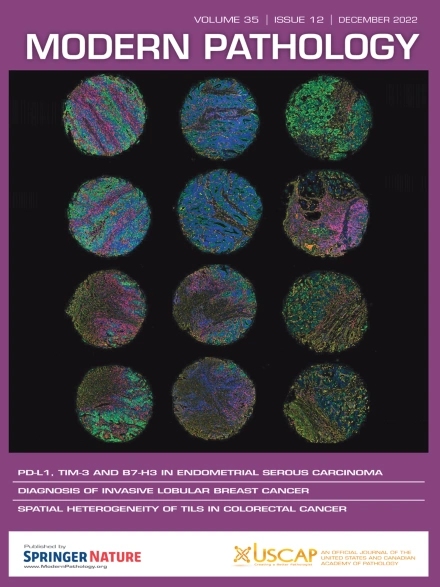从 LYSA 全切片图像预测大 B 细胞淋巴瘤中的 MYC 重排:自我监督深度学习模型的多中心验证。
IF 7.1
1区 医学
Q1 PATHOLOGY
引用次数: 0
摘要
大 B 细胞淋巴瘤(LBCL)是一种异质性淋巴恶性肿瘤,其中 MYC 基因重排(MYC-R)与预后不良有关,因此建议进行更深入的治疗。MYC-R 的检测依赖荧光原位杂交(FISH)方法,这种方法耗时长、成本高,而且并非所有实验室都能采用。在苏木精和伊红(HE)染色的LBCL全切片图像(WSI)上自动检测MYC-R将减少对昂贵的分子检测的需求,并提高病理学家的工作效率。考虑到自监督学习的最新进展,我们开发了一种可解释的深度学习(DL)算法来检测 MYC-R,并对七种特征提取器和六种多实例学习模型进行了广泛比较。四个不同的多中心队列(包括 1 247 名 LBCL 患者)被用于训练和验证。在对最大的 LBCL 队列进行交叉验证时,最佳 DL 模型的平均 ROC AUC 得分为 81.9%,在对其他未见队列进行评估时,ROC AUC 得分为 62.2% 到 74.5%。此外,我们还证明,使用该模型作为预筛工具(假阴性率为 0%),可避免 35% 的病例进行 FISH 检测。这项工作证明了在日常实践中开发一种医疗设备来有效检测 HE WSI 上 MYC 基因重排的可行性。本文章由计算机程序翻译,如有差异,请以英文原文为准。
MYC Rearrangement Prediction From LYSA Whole Slide Images in Large B-Cell Lymphoma: A Multicentric Validation of Self-supervised Deep Learning Models
Large B-cell lymphoma (LBCL) is a heterogeneous lymphoid malignancy in which MYC gene rearrangement (MYC-R) is associated with a poor prognosis, prompting the recommendation for more intensive treatment. MYC-R detection relies on fluorescence in situ hybridization method which is time consuming, expensive, and not available in all laboratories. Automating MYC-R detection on hematoxylin-and-eosin–stained whole slide images of LBCL would decrease the need for costly molecular testing and improve pathologists’ productivity. We developed an interpretable deep learning algorithm to detect MYC-R considering recent advances in self-supervised learning and providing an extensive comparison of 7 feature extractors and 6 multiple instance learning models, themselves. Four different multicentric cohorts, including 1247 patients with LBCL, were used for training and validation. The best deep learning model reached an average area under the receiver operating characteristic curve score of 81.9% during crossvalidation on the largest LBCL cohort, and area under the receiver operating characteristic curve scores ranging from 62.2% to 74.5% when evaluated on other unseen cohorts. In addition, we demonstrated that using this model as a prescreening tool (with a false-negative rate of 0%), fluorescence in situ hybridization testing would be avoided in 35% of cases. This work demonstrates the feasibility of developing a medical device to efficiently detect MYC gene rearrangement on hematoxylin-and-eosin–stained whole slide images in daily practice.
求助全文
通过发布文献求助,成功后即可免费获取论文全文。
去求助
来源期刊

Modern Pathology
医学-病理学
CiteScore
14.30
自引率
2.70%
发文量
174
审稿时长
18 days
期刊介绍:
Modern Pathology, an international journal under the ownership of The United States & Canadian Academy of Pathology (USCAP), serves as an authoritative platform for publishing top-tier clinical and translational research studies in pathology.
Original manuscripts are the primary focus of Modern Pathology, complemented by impactful editorials, reviews, and practice guidelines covering all facets of precision diagnostics in human pathology. The journal's scope includes advancements in molecular diagnostics and genomic classifications of diseases, breakthroughs in immune-oncology, computational science, applied bioinformatics, and digital pathology.
 求助内容:
求助内容: 应助结果提醒方式:
应助结果提醒方式:


